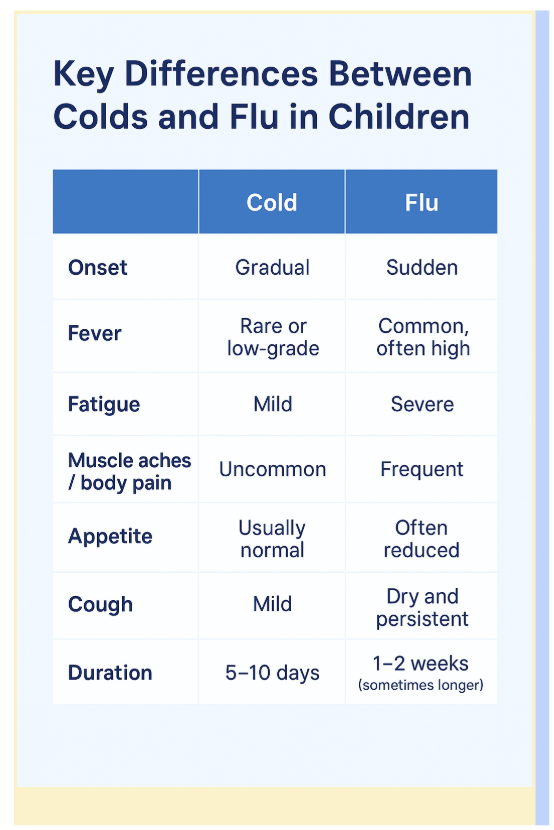Recognising the Signs: Cold vs. Flu in Children
As the cooler months arrive, it’s common for children to pick up seasonal illnesses. While most colds are mild and resolve within a few days, influenza (flu) can be more serious, particularly for young children or those with underlying health conditions. At Childhealthy, our team breaks down the key differences between colds and flu in children, helping you recognise the signs and know when to seek medical advice.

Common symptoms of a cold
Colds are caused by a range of viruses and usually develop gradually. Typical symptoms include:
- Runny or blocked nose – often clear at first, then may thicken
- Sneezing
- Mild sore throat
- Low-grade fever (occasionally)
- Coughing – usually mild
- Fatigue or irritability
Colds are generally mild and children remain active, although they may feel a little under the weather. Symptoms typically last between 5 and 10 days, and most can be managed at home with rest, hydration, and comfort measures.
How flu differs from a cold
Influenza is caused by the influenza virus and tends to appear suddenly. Flu symptoms are often more severe than those of a cold and can include:
- High fever – often over 38°C, accompanied by chills
- Muscle aches and headaches – children may complain of body pain or lethargy
- Extreme fatigue – they may want to sleep more than usual and struggle with normal activities
- Dry cough – can be persistent
- Sore throat – sometimes more pronounced than with a cold
- Vomiting or diarrhoea – more common in younger children
Flu can lead to complications, particularly in children with asthma, diabetes, or weakened immune systems. Unlike colds, flu often causes children to appear visibly unwell, with a sudden decline in energy and appetite.
Key differences to watch for
Understanding the differences between colds and flu can guide how you care for your child:

While these are general patterns, symptoms can overlap. Some children with flu may have mild symptoms, and some colds may cause high temperatures.
Managing colds and flu at home
Most mild colds can be managed safely at home with:
- Plenty of fluids to stay hydrated
- Lots of rest
- Age-appropriate pain relief or fever reducers, such as paracetamol or ibuprofen, following dosage guidance
- Warm, soothing foods like soups and porridge
For flu, supportive care is similar, but children may need closer monitoring due to the risk of complications. Encourage rest, hydration, and monitor for any worsening symptoms.
When to seek medical advice
Contact a healthcare professional if your child:
- Has difficulty breathing or wheezing
- Is unusually drowsy or unresponsive
- Develops a persistent high fever not relieved by medication
- Experiences severe vomiting or signs of dehydration
- Shows signs of an unusual rash or worsening condition
Early assessment is particularly important for children under five or those with underlying health conditions.
Preventive measures
Vaccination remains the most effective way to protect children against flu. Seasonal flu vaccines are recommended annually and help reduce the risk of severe illness. Good hand hygiene, covering coughs and sneezes, and encouraging children to stay home when unwell also help prevent the spread of viruses.
By recognising the differences between a cold and flu, parents can respond appropriately, provide comfort at home, and seek medical support when necessary. Staying informed and observant ensures children receive timely care and recover safely during the autumn and winter months.
Sources:
Disclaimer: This information is for educational purposes and is not a substitute for professional medical advice. Always consult a healthcare professional regarding your child’s health.
Related articles
Book your appointment
Clinic, remote appointments and home visits are available daily.
We can always find a time to suit you, so please do ask if you are having difficulty finding a suitable time.




